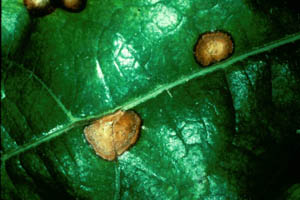What Are Those Spots on My Ivy? | |
|---|---|
| May 8, 2006 | |
|
English ivy, Hedera helix, is very common in shady, landscaped areas in Illinois. As ivy growth become dense, diseases can become a problem, especially during wet or humid weather in shady locations. Several of these diseases are discussed here. Bacterial leaf spot and stem canker is more common in Illinois. Logically, it is also harder to control. This disease thrives in warm, wet weather and can be easily spread from plant to plant by splashing water. Bacterial leaf spot first appears as small, circular, dark green, and water-soaked (oily-looking) areas on ivy leaves. These spots enlarge and have a red–brown to black center with a water-soaked margin. Sometimes, a yellow halo appears around the lesion. In image 060402, you can clearly see a yellow halo around a bacterial lesion.  Look at suspect leaves with back lighting to see the halo more clearly. The bacterial spots dry and crack as they age. The bacterial pathogen can also cause black cankers on stems and petioles, causing stems to die. There are many fungal pathogens that can cause leaf spots on English ivy. They all require water droplets for growth, therefore all of the fungal leaf spots are also spread by splashing water. Initially, fungal leaf spots may appear very similar to bacterial leaf spots on Hedera helix. In general, fungal leaf spots are red to brown in color and irregular in shape. Certain fungal species may cause lesions to have concentric rings or depressed centers. Fungal leaf spots form fruiting bodies containing spores. These fruiting bodies are small (pinhead-sized), black, and embedded within the leaf spot, as shown in image 060403.  Anthracnose of ivy is one of the fungal diseases. It has already appeared at the clinic this season. The pathogen that infects Hedera helix is a Colletotrichum species. This disease often occurs after injury, including injury from environmental stress. For more information about these diseases, refer to Report on Plant Disease (RPD), no. 652, “Leaf Spot Diseases of English Ivy,” available at http://www.ag.uiuc.edu/~vista/horticul.htm or in printed form at University of Illinois Extension offices. Before introducing English ivy into your landscape, carefully inspect it for any sign of disease. Remove any questionable leaves from new plants and old leaves or debris from established plants each spring to protect new growth. Avoid working with wet plants. Both bacterial and fungal leaf pathogens require moisture for infection, so try to water ivy beds from below and early in the day. If leaf spots are severe, fungicides may be applied when new leaf growth begins in the spring. Follow label directions for repeat applications. This protects new growth as it emerges. Registered chemicals are listed in the Illinois Commercial Landscape and Turf-grass Pest Management Handbook and the Home, Yard and Garden Pest Guide. If you cannot distinguish between fungal and bacterial pathogens, choose a product that controls both, such as one of the copper fungicides. The chemical mobility is listed at the end of the disease chapters in the pest guides listed above. Protectant fungicides may have to be repeated if wet weather persists. (Stephanie Porter; Note: Stephanie has written for us before, as Stephanie Satterlee.) |